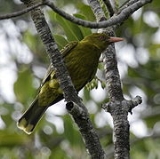
Australasian Yellow Oriole
Encyclopedia
The Yellow Oriole or Green Oriole, (Oriolus flavocinctus) is an inconspicuous inhabitant of lush tropical vegetation throughout New Guinea
and northern Australia
, including Cape York Peninsula
, the Top End
and the Kimberley
.
This species should not be confused with the South America
n Yellow Oriole
, which is an icterid
.
Yellow Orioles forage slowly and methodically through the mid and upper strata of dense forests, taking fruit in the main. Typically alone or in pairs, they sometimes form small flocks in the non-breeding season. They are often difficult to locate, as their yellow-green plumage blends with the foliage and only their deep bubbling musical calls can be heard. They are nevertheless common in suitable habitat: rainforest
s, mangrove
s, thickets along watercourses, swamp
s, and lush gardens.
Breeding takes place during the wet season (October to March). A neat, deep cup is constructed from strips of bark and vines, lined with rootlets, and slung between leafy branches, usually 5 to 15 metres up. They typically lay 2 eggs.
New Guinea
New Guinea is the world's second largest island, after Greenland, covering a land area of 786,000 km2. Located in the southwest Pacific Ocean, it lies geographically to the east of the Malay Archipelago, with which it is sometimes included as part of a greater Indo-Australian Archipelago...
and northern Australia
Australia
Australia , officially the Commonwealth of Australia, is a country in the Southern Hemisphere comprising the mainland of the Australian continent, the island of Tasmania, and numerous smaller islands in the Indian and Pacific Oceans. It is the world's sixth-largest country by total area...
, including Cape York Peninsula
Cape York Peninsula
Cape York Peninsula is a large remote peninsula located in Far North Queensland at the tip of the state of Queensland, Australia, the largest unspoilt wilderness in northern Australia and one of the last remaining wilderness areas on Earth...
, the Top End
Top End
The Top End of northern Australia is the second northernmost point on the continent. It covers a rather vaguely-defined area of perhaps 400,000 square kilometres behind the northern coast from the Northern Territory capital of Darwin across to Arnhem Land with the Indian Ocean on the west, the...
and the Kimberley
Kimberley region of Western Australia
The Kimberley is one of the nine regions of Western Australia. It is located in the northern part of Western Australia, bordered on the west by the Indian Ocean, on the north by the Timor Sea, on the south by the Great Sandy and Tanami Deserts, and on the east by the Northern Territory.The region...
.
This species should not be confused with the South America
South America
South America is a continent situated in the Western Hemisphere, mostly in the Southern Hemisphere, with a relatively small portion in the Northern Hemisphere. The continent is also considered a subcontinent of the Americas. It is bordered on the west by the Pacific Ocean and on the north and east...
n Yellow Oriole
South American Yellow Oriole
The Yellow Oriole, Icterus nigrogularis, is a passerine bird in the family Icteridae. It should not be confused with the Australasian Yellow Oriole, Oriolus flavocinctus, which is an Old World oriole...
, which is an icterid
Icterid
The Icterids are a group of small to medium-sized, often colorful passerine birds restricted to the New World. Most species have black as a predominant plumage color, often enlivened by yellow, orange or red. The family is extremely varied in size, shape, behavior and coloration...
.
Yellow Orioles forage slowly and methodically through the mid and upper strata of dense forests, taking fruit in the main. Typically alone or in pairs, they sometimes form small flocks in the non-breeding season. They are often difficult to locate, as their yellow-green plumage blends with the foliage and only their deep bubbling musical calls can be heard. They are nevertheless common in suitable habitat: rainforest
Rainforest
Rainforests are forests characterized by high rainfall, with definitions based on a minimum normal annual rainfall of 1750-2000 mm...
s, mangrove
Mangrove
Mangroves are various kinds of trees up to medium height and shrubs that grow in saline coastal sediment habitats in the tropics and subtropics – mainly between latitudes N and S...
s, thickets along watercourses, swamp
Swamp
A swamp is a wetland with some flooding of large areas of land by shallow bodies of water. A swamp generally has a large number of hammocks, or dry-land protrusions, covered by aquatic vegetation, or vegetation that tolerates periodical inundation. The two main types of swamp are "true" or swamp...
s, and lush gardens.
Breeding takes place during the wet season (October to March). A neat, deep cup is constructed from strips of bark and vines, lined with rootlets, and slung between leafy branches, usually 5 to 15 metres up. They typically lay 2 eggs.

